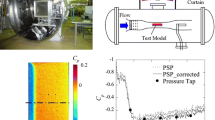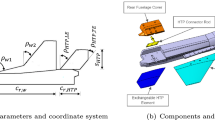Abstract
Leading-edge vortices on a simple delta wing were visualized by using pressure-sensitive paint (PSP). PSP is an optical pressure measurement technique based on oxygen quenching of luminescent molecules. In the present study, we used PSP composed of platinum octaethylporphyrine (PtOEP) and fluoropolymer (poly-IBM-co-TFEM [Poly (isobutylmethacrtlate-co-trifluoroethylate)]). This new paint has higher sensitivity to pressure and lower sensitivity to temperature than previous ones, reducing an error due to temperature variation during a wind tunnel test. A thin coating of PSP was applied to a delta wing model with 70-degree leading-edge sweep. The coating was excited by Xenon light and emission from the coating was detected by a high-resolution CCD camera. Tests were done at subsonic speeds in the 0.2-m Supersonic Wind Tunnel at the National Aerospace Laboratory in Japan. Complicated flow structures on the delta wing including primary and secondary vortices were clearly visualized using pressure-sensitive paint. An a priori calibration technique was used to convert measured luminescent intensity into pressure. The obtained pressure distributions were in good agreement with pressure tap data. Pressure maps were obtained for various Mach numbers, Reynolds numbers and angles of attack. It was found that an increase in Mach number delayed vortex breakdown while Reynolds number had little effect on the vortex formation.
Similar content being viewed by others
References
Amao, Y., Asai, K., Miyasita, T. and Okura, I., Photophysical and Photochemical Properties of Optical Oxygen Pressure Sensor of Platinum Porphyrin-Isobutylmethacrylate-Trifluoroethylmethacrylate Copolymer Film, Polymer Journal, 31–12 (1999), 1267–1296.
Elsenaar, A., Hjelmberg, L. and Buetefisch, K., The International Vortex Flow Experiment, AGARD CP-437, Paper 9, (1988).
Liu, T., Guille, M. and Sullivan, J. P., Uncertainty Analysis of Pressure Sensitive Paint Measurement, AIAA Paper 99-3785 (1999).
Liu, T., Campbell, B. T., Burns, S. P. and Sullivan, J. P., Temperature and Pressure-Sensitive Luminescent Paints in Aerodynamics, Apl. Mech. Rev., 50–4 (1997), 227–246.
Shimbo, Y., Mehta, D. R. and Cantwell, J. B., Vortical Flow Field Investigation Using the Pressure Sensitive Paint Technique at Low Speed, AIAA Paper 97-0388 (1997).
Shimbo, Y., Asai, K., Kanda, H., Iijima, I., Komatu, N., Kita, S. and Ishiguro, M., Evaluation of Several Calibration Techniques for Pressure Sensitive Paint in Transonic Testing, AIAA Paper 98-2502 (1998).
Author information
Authors and Affiliations
Additional information
Yasuhiro Egami: He received his B.Sc. (Eng.) degree in 1992 and Doctor degree of Engineering in 1997 in Tohoku University in Japan. He worked as a research associate at Institute of Fluid Science, Tohoku University from 1997 to 1999. He worked as an invited researcher at Karlsruhe University during 1998-1999. He started to work as a research fellow at National Aerospace Laboratory since 1999. His current research interest is to develop PSP and TSP technique and their application to fluid dynamics testing.
Yoshimi Iijima: He received the B.E. degree in Electrical Engineering from Science University of Tokyo in 1997. He has been working at National Aerospace Laboratory since 1992. His current research interest is to develop PSP and TSP technique and their application to fluid dynamics testing.
Yutaka Amao: He received Doctor degree of Engineering in 1997 in Tokyo Institute of Technology in Japan. He worked as a researcher at Kanagawa Academy of Science and Technology from 1997 to 1998. He started to work as a research fellow at National Aerospace Laboratory since 1998. His current research interest is to develop optical sensor technique using photofunctional materials.
Keisuke Asai: He graduated from Kyoto University in 1980 (Bachelor of Aeronautical Engineering) and received PhD (Aerospace Engineering) from The University of Tokyo in 1995. He has been working as a research scientist at National Aerospace Laboratory since 1980. His current position is group leader of Advance Measurement Technology Group in Fluid Science Research Center. He also serves as project manager of MOSAIC, an interdisciplinary R&D project to develop molecular sensor technology for aero-thermodynamic research. He is Associate Fellow of AIAA, Member of JSASS and Visualization Society of Japan.
Akihiko Fuji: He graduated from The Tokyo University of Agriculture and Technology, and received the B.Sc. (Eng.) degree in 2000. He is a master course student of the same University. The objective of his present study is fatigue analysis of rolling bearing.
Norikazu Teduka : He graduated from The Tokyo University of Agriculture and Technology, and received the B.Sc. (Eng.) degree in 1999. He is a master course student of the same University. The objective of his study is time response of PSPs for using in unsteady pressure measurements.
Masaharu Kameda: He received his B.S., M.S. and Ph.D. degrees in Mechanical Engineering from The University of Tokyo in 1989, 1991 and 1994, respectively. After he received his Ph.D. degree, he has been affiliated with the Department of Mechanical Systems Engineering at The Tokyo University of Agriculture and Technology (TUAT), where he is now an associate professor. His research has been in the field of bubble dynamics, nonlinear acoustics, aerodynamics and flow visualization.
Rights and permissions
About this article
Cite this article
Egami, Y., Iijima, Y., Amao, Y. et al. Quantitative visualization of the leading-edge vortices on a delta wing by using pressure-sensitive paint. J Vis 4, 139–150 (2001). https://doi.org/10.1007/BF03182567
Received:
Revised:
Issue Date:
DOI: https://doi.org/10.1007/BF03182567




